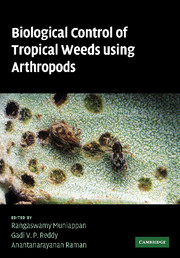Book contents
- Frontmatter
- Contents
- List of contributors
- Acknowledgments
- 1 Biological control of weeds in the tropics and sustainability
- 2 Acacia nilotica ssp. indica (L.) Willd. ex Del. (Mimosaceae)
- 3 Australian Acacia species (Mimosaceae) in South Africa
- 4 Ageratina adenophora (Sprengel) King and Robinson (Asteraceae)
- 5 Azolla filiculoides Lamarck (Azollaceae)
- 6 Cabomba caroliniana Gray (Cabombaceae)
- 7 Invasive cactus species (Cactaceae)
- 8 Chromolaena odorata (L.) King and Robinson (Asteraceae)
- 9 Clidemia hirta (L.) D. Don (Melastomataceae)
- 10 Coccinia grandis (L.) Voigt (Cucurbitaceae)
- 11 Eichhornia crassipes (Mart.) Solms–Laub. (Pontederiaceae)
- 12 Lantana camara Linn. (Verbenaceae)
- 13 Mimosa diplotricha C. Wright ex Sauvalle (Mimosaceae)
- 14 Mimosa pigra L. (Leguminosae)
- 15 Parthenium hysterophorus L. (Asteraceae)
- 16 Passiflora mollissima (HBK) Bailey (Passifloraceae)
- 17 Pistia stratiotes L. (Araceae)
- 18 Prosopis species (Leguminosae)
- 19 Salvinia molesta D. S. Mitchell (Salviniaceae)
- 20 Solanum mauritianum Scopoli (Solanaceae)
- 21 Application of natural antagonists including arthropods to resist weedy Striga (Oranbanchaceae) in tropical agroecosystems
- 22 Biological control of weeds in India
- 23 The role of International Institute of Tropical Agriculture in biological control of weeds
- 24 The role of Secretariat of the Pacific Community in the biological control of weeds in the Pacific Islands region – past, present, and future activities
- Index
11 - Eichhornia crassipes (Mart.) Solms–Laub. (Pontederiaceae)
Published online by Cambridge University Press: 04 August 2010
- Frontmatter
- Contents
- List of contributors
- Acknowledgments
- 1 Biological control of weeds in the tropics and sustainability
- 2 Acacia nilotica ssp. indica (L.) Willd. ex Del. (Mimosaceae)
- 3 Australian Acacia species (Mimosaceae) in South Africa
- 4 Ageratina adenophora (Sprengel) King and Robinson (Asteraceae)
- 5 Azolla filiculoides Lamarck (Azollaceae)
- 6 Cabomba caroliniana Gray (Cabombaceae)
- 7 Invasive cactus species (Cactaceae)
- 8 Chromolaena odorata (L.) King and Robinson (Asteraceae)
- 9 Clidemia hirta (L.) D. Don (Melastomataceae)
- 10 Coccinia grandis (L.) Voigt (Cucurbitaceae)
- 11 Eichhornia crassipes (Mart.) Solms–Laub. (Pontederiaceae)
- 12 Lantana camara Linn. (Verbenaceae)
- 13 Mimosa diplotricha C. Wright ex Sauvalle (Mimosaceae)
- 14 Mimosa pigra L. (Leguminosae)
- 15 Parthenium hysterophorus L. (Asteraceae)
- 16 Passiflora mollissima (HBK) Bailey (Passifloraceae)
- 17 Pistia stratiotes L. (Araceae)
- 18 Prosopis species (Leguminosae)
- 19 Salvinia molesta D. S. Mitchell (Salviniaceae)
- 20 Solanum mauritianum Scopoli (Solanaceae)
- 21 Application of natural antagonists including arthropods to resist weedy Striga (Oranbanchaceae) in tropical agroecosystems
- 22 Biological control of weeds in India
- 23 The role of International Institute of Tropical Agriculture in biological control of weeds
- 24 The role of Secretariat of the Pacific Community in the biological control of weeds in the Pacific Islands region – past, present, and future activities
- Index
Summary
Introduction
Eichhornia crassipes (Mart.) Solms-Laub. (water hyacinth; Pontederiaceae), an erect free-floating herbaceous plant, is indigenous to tropical South America (Gopal, 1987), but has been spread throughout the world. In the absence of its original suite of natural enemies, and usually in nutrient-enriched waters, it quickly becomes invasive, and is now the most important aquatic weed worldwide (Center, 1994; Julien et al., 1996). It colonizes still or slow moving waters, resulting in thick extensive mats, which impede water traffic, reduce water quality (Edwards and Musil, 1975), and alter social structures for human riparian communities, such as those living on the Sepik River of Papua New Guinea. Infestations continue to plague freshwater bodies, particularly in tropical Africa (Navarro and Phiri, 2000), India (Kathiresan, 2000), and China (Ding et al., 2001), causing significant environmental, economic and social problems, particularly for communities reliant on water bodies for sustenance and survival (Fig. 11.1).
Taxonomy
Eichhornia crassipes is in the Pontederiaceae, a taxonomically problematic family, which has recently been included in the Commelinales (APG II, 2003; Strange et al., 2004). Eight other genera occur in this family of predominantly neotropical, freshwater aquatics, and eight species in the genus Eichhornia (Cook, 1998), all of which originated in South America, except E. natans (P. Beauv.) which is native to tropical Africa (Gopal, 1987). Only E. crassipes is regarded as a pantropical aquatic weed. The common names of E. crassipes are “water hyacinth”, ‘waterhyacinth’ or “water-hyacinth.”
- Type
- Chapter
- Information
- Biological Control of Tropical Weeds Using Arthropods , pp. 183 - 210Publisher: Cambridge University PressPrint publication year: 2009
- 19
- Cited by

